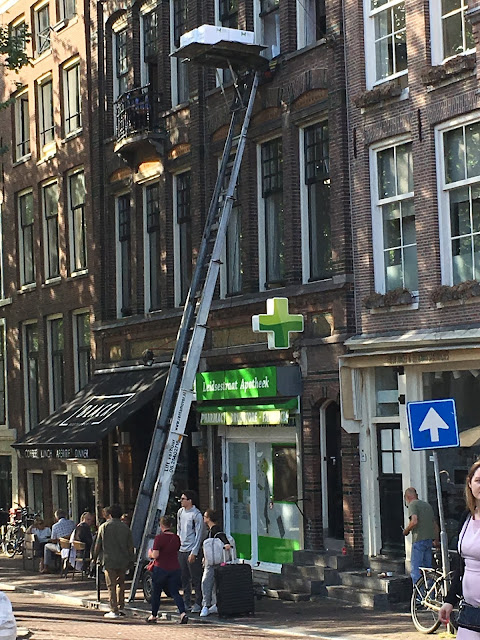The Molen Van Sloten Windmill
The Sloten Windmill is one of the last remaining working windmills in Amsterdam. Once upon a time there were over 10,000 windmills in the Netherlands. Today there are only about 1000 left, scattered throughout the country. Some do not operate and are attractions, or have been made into B&Bs. This windmill is still operational, although it is little used these days. It is also open to the public for tours, and staffed by volunteers, who love their windmill.
We arrived around noon and looked around in the museum where there was an exhibit of old tools and artifacts gathered together to give one an idea of what it was like when this windmill was part of the water removal system for the polders. (Reclaimed land below sea level.))
This windmill was a water lifting windmill. It lifted water utilizing an Archimedies screw at a rate of 60,000 liters per minute (about 16.000 gallons). It lifted the water 1½ meters and dumped it into a canal that went into the sea. It was the last in a series of three windmills. each lifting water 1½ meters. The first one sent the water into a low canal. The second windmill lifted that water into a higher canal and the third windmill, this one, lifted water into a still higher canal that went out to sea. Very ingenious. It kept the polder dry. Today modern pumps do the work.
 |
| Our Guide, Harry, showing us the how the water removal system worked. |
 |
| The Archimedies Screw lifts water from one level to the next. |
The Village of Sloten was a favorite place for Rembrandt to come and paint. In fact he met his wife in this town. You see windmills in many of his etchings.
 |
| We are sitting, picnicing, with Rembrandt sketching his wife, who he met in this little town of Sloten. That is my granddaughter's hat on Rembrandt. |
The water levels are constantly monitored. When necessary this windmill can come on-line to pump water, although it is little used these days. Modern technology has rendered it obsolete. However it is kept is working order by a series of dedicated volunteers, who maintain the windmill and offer tours to the few tourists that venture out.
 |
This 'stick' measures the water level. The top where it says NAP is sea level. All the numbers down the stick are distances BELOW sea level.
|
 |
| Some of the gears, turning that transfers power from one direction to the mail axel. |
Gears transferring energy, through various set of gears, from the sails down to the Archimedes screw that lifted water.
The windmill had to be raised in 1991 because the village of Sloten had grown up so much that the wind was cut off from the windmill, by the newer, taller buildings. So an extra two levels were added, with the original windmill set on top of the two new levels. Those room are used today for weddings and other gatherings--you too can be married and have your reception in a working windmill. What fun!
 |
| Coming down from the very top of the windmill via a very steep stair/ladder. You see one of the gears turning the center axle. |
 |
| Another view of the old wooden gearing which transfers the energy from one direction to another.. |
There many types of windmills in the Netherlands. With over 10,000 at one point in time, the windmills were designed to do various types of work. Some ground wheat into flour. Some were sawmills. Some were pumps. Whatever required power to operate, could utilize the energy produced by the windmill.
 |
| A Model of the van Sloten windmill before the two new levels were added. |
 |
| A working model of a sawmill windmill. Windmills came in all shapes and sizes and were designed to do specific kinds of work. |









































